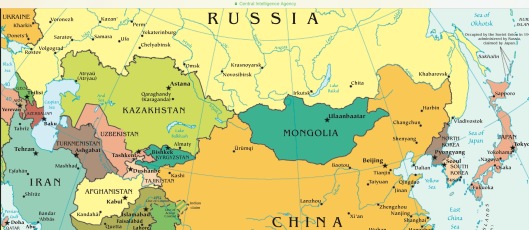Tags
China, CIS, energy politics, Flaring, fossil fuels, Gazprom, Lukoil, natural gas, oil and gas, pipeline politics, pipelines, Russia, terrorism, Uzbekistan

Map Showing Uzbekistan in regional context, cropped from CIA gov map
From the EIA (US Energy Information Administration:
“Last Updated: July 2016
Overview
* Total primary energy consumption in Uzbekistan was about 2.05 quadrillion British thermal units (Btu) in 2015, according to BP’s 2016 Statistical Review. Natural gas accounted for the majority of consumption (88%), while consumption of petroleum products (5%), coal (2%), and hydroelectricity (5%) accounted for the remainder. Uzbekistan holds sizeable hydrocarbon reserves of natural gas, and its economy is highly dependent on the country’s energy resources.
* Uzbekistan maintained state control over hydrocarbon resources following the end of the Soviet Union. In 1992, the country formed the state company, Uzbekneftegaz, to manage the oil and natural gas sectors.
* Russia’s Lukoil and Gazprom and China National Petroleum Corporation (CNPC) are among the most heavily invested companies in Uzbekistan’s oil and natural gas industries.
Oil
* Uzbekistan had 594 million barrels of proven crude oil reserves in 2016, according to Oil and Gas Journal. In 2015, total petroleum and other liquids production was 78,900 barrels per day (b/d). Roughly 60% of Uzbekistan’s known oil and natural gas fields are located in the Bukhara-Khiva region. The region is the source of approximately 70% of the country’s oil production.
* Uzbekistan has three oil refineries located in Ferghana, Alty-Arik, and Bukhara, with a total crude oil distillation capacity of 232,000 b/d. The refineries typically operate below capacity because of insufficient domestic oil production.
* Uzbekistan’s sole domestic crude oil pipeline links the Ferghana and Alty-Aryk refineries. Uzbekistan has virtually no international oil pipeline infrastructure. A single crude oil pipeline runs through Uzbekistan, linking the Shymkent refinery in Kazakhstan to the Chardzhou refinery in northeastern Turkmenistan.
* Decreases in oil production have prompted Uzbekistan’s government to largely abandon an inward-focused energy policy that promoted self-sufficiency and subsidized domestic prices. New laws aim to attract foreign investment in order to boost oil production and reserves. State-run oil and gas company Uzbekneftegaz, for example, is actively seeking production-sharing agreements and joint ventures with international partners.
Natural gas
* In 2015, Uzbekistan was the third largest natural gas producer in Eurasia, following Russia and Turkmenistan. The country produced just over 2 trillion cubic feet (Tcf) of natural gas in 2015, and consumed roughly 1.8 Tcf of natural gas the same year according to the BP Statistical Review of World Energy 2016.
* Uzbekistan had 65 Tcf of proven natural gas reserves as of January 2016.
According to National Oceanic and Atmospheric Administration estimates, Uzbekistan flared about 45 billion cubic feet (Bcf) of natural gas in 2014, a significant reduction since 2006.
* Uzbekistan serves as a transit country for natural gas flowing from Turkmenistan to Russia and China. Uzbekistan exported almost 265 Bcf of natural gas in 2015, with nearly half sent to Russia and the remainder sent to China and Kazakhstan.
In addition, two new natural gas pipelines, Gazli-Kagan and Gazli-Nukus, were built to connect the Ustyurt and Bukhara-Khiva region with the existing pipeline system.
* Uzbekistan currently has a gas export agreement with China to send 350 Bcf per year through the third line of the Central Asia-China gas pipeline. In 2013, China signed agreements with Uzbekistan and other Central Asian nations to construct a fourth line of the pipeline. As of 2016, however, the project has been delayed, and the pipeline is not expected to begin operations until around 2020.
* In 2016, Russia’s Lukoil and Uzbekneftegaz began construction of the Kandym Gas Processing Complex (KGPC) in the Bukhara Province of southwestern Uzbekistan. Upon completion, Lukoil anticipates that the plant will process more than 280 Bcf of gas per year, making it one of the largest gas treatment facilities in Central Asia.
* Electricity
* Uzbekistan has an electrification rate of nearly 100%, and a total installed capacity of 12,400 megawatts. However, due to the country’s aging Soviet-era infrastructure as well as increasing electricity demand, supply shortages may increase over the next several years according to analysis from the World Bank.
* Natural gas-fired thermal plants are the country’s primary source of power generation, supplying nearly 90% of the country’s total power, while the remaining electricity is supplied by hydropower stations. Uzbekistan’s power system contributes significantly to the power generating capacity of the Central Asia Power System (CAPS), an integrated power transmission network linking several Central Asian nations. Uzbekistan is also the primary electricity supplier to neighboring Afghanistan.”
https://www.eia.gov/beta/international/analysis.cfm?iso=UZB

You must be logged in to post a comment.